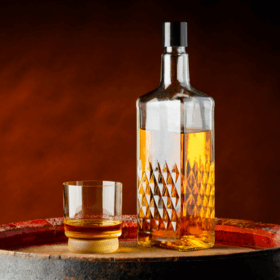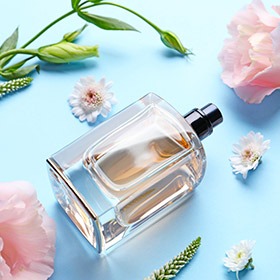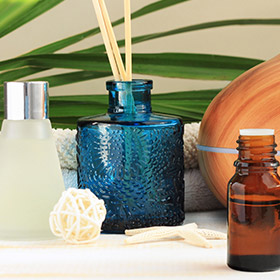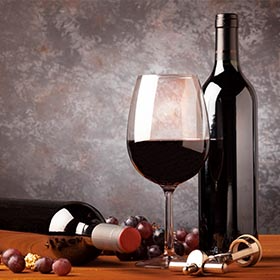Introduction
Take a look at the bottle of liquor next to you. Is it 70cl or 750ml? The most prevalent glass bottle sizes in the global liquor market are 70cl and 750ml. At first glance, they might seem almost identical—after all, it’s just a 50ml difference—but for distributors, retailers, and liquor brands, that small gap can mean the difference between perfect compliance and costly mistakes, premium perception and consumer confusion, or even smooth logistics and shipping headaches.
Whether you’re sourcing glass liquor bottles wholesale, creating a new whiskey line, or expanding your export markets, understanding the subtle but crucial differences between these bottles is key. In this guide, we will explore the mystrey of 70cl and 750ml. By the end of this article, you’ll know why your next batch of round liquor bottles, square liquor bottles, or fancy liquor bottles should be one size over the other—and how to leverage them to boost your brand image and sales.

Understanding 70cl and 750ml
What is a 70cl Bottle?
A 70cl bottle (700ml) is the standard spirit size across Europe, thanks to EU regulations. Beyond compliance, it’s popular with consumers who see it as the perfect balance: big enough for personal enjoyment yet compact enough for gifting.
You’ll find 70cl glass bottles used for whiskey, gin, rum, vodka, brandy, and tequila—especially in premium and craft segments where the smaller size signals exclusivity and quality. Its history is tied to Europe’s metrication movement, but today it’s more than regulation—it’s a trusted format that drives both retail strategy and consumer preference.

What is a 750ml Bottle?
The 750ml bottle (75cl) is the world’s most recognized size, dominating the U.S., Canada, and much of Asia. Known as a “fifth” in the U.S. (one-fifth of a gallon), it carries historical weight and modern convenience.
This size is the gold standard for wine—from table wines to luxury vintages—and just as common for whiskey, vodka, gin, and rum. Champagne and sparkling wines also rely on 750ml, reinforcing its versatility.
Its adoption was shaped by U.S. regulations in the late 19th century, which standardized spirits packaging for trade and taxation. Today, it’s a global default: consumers recognize it, distributors expect it, and glass liquor bottles wholesale in this size are everywhere. For brands aiming for broad market appeal, the 750ml bottle remains indispensable.
70cl vs 750ml Glass Bottles – The Key Differences
Volume and Measurement
Actually, the most apparent difference between these two bottle sizes is in their volume. A 70cl bottle contains 700 milliliters (ml), whereas a 750ml bottle contains, as its name suggests, 750 milliliters. This mathematical difference means that a 70cl bottle holds 50ml less liquid than a 750ml bottle. While 50ml might seem negligible, it translates to a tangible difference in servings and perceived value, especially when considering the cumulative effect across large volumes of glass liquor bottles wholesale.
Regional Standards and Regulations
Europe (70cl standard for spirits): The European Union has largely standardized the 70cl size for spirits. This move was part of a broader effort to harmonize trade within the bloc, ensuring consistency for consumers and streamlining manufacturing and distribution processes. This adherence to a uniform size simplifies cross-border trade and reduces complexity for producers aiming to sell their spirits across multiple EU countries. For instance, a liquor brand from French will be easily accepted in Italy or Spain as they insist the same size standard.
USA & North America (750ml standard): In stark contrast, the 750ml bottle remains the predominant standard for spirits and wines in the United States and much of North America. This preference is deeply ingrained in the region’s historical context and consumer habits. While manufacturers in the U.S. have more flexibility in exploring various bottle sizes compared to the strict EU regulations, the 750ml size continues to be the most widely accepted and recognized. This means that for companies looking to export their fancy liquor bottles or unique liquor bottles for sale to the U.S. market, adhering to the 750ml standard is often a prerequisite for success.
Asia (mixed adoption, depending on export requirements): The Asian market presents a more complex picture, often exhibiting mixed adoption of both 70cl and 750ml standards. This is largely influenced by the origin of the products and the specific export requirements of different countries within Asia. For example, spirits imported from Europe might retain their 70cl packaging, while those from North America or locally produced spirits might opt for the 750ml size.
Compliance Issues: FDA (U.S.) vs EU alcohol packaging laws: The regulatory differences between the U.S. and the EU are a critical consideration for global liquor brands. The U.S. Food and Drug Administration (FDA) and the Alcohol and Tobacco Tax and Trade Bureau (TTB) have specific requirements for alcohol packaging, including permissible bottle sizes. Similarly, the EU has its own set of directives that dictate bottle volumes for spirits. Brands must ensure their chosen glass bottle alcohol drinks packaging complies with the legal framework of their target markets to avoid penalties, product recalls, or barriers to entry. This often involves working closely with glass bottle manufacturers who understand these international standards and can provide appropriate glass bottles for liquor.
Production and Cost Considerations
From a manufacturing perspective, the primary consideration is the amount of glass required. A 750ml bottle, being larger, naturally consumes more raw materials than a 70cl bottle. While the difference per bottle is small, it accumulates significantly when dealing with glass liquor bottles wholesale orders. This can impact the overall cost of production, especially for large-scale operations.
Shipping and logistics represent another critical cost component. The weight and dimensions of the bottles, both empty and filled, directly impact freight costs. A slight difference in bottle dimensions can mean fitting fewer or more bottles per pallet or container, directly affecting per-unit shipping costs. For example, if a container can fit 10,000 750ml bottles, it might be able to fit 10,500 70cl bottles, leading to a marginal but impactful saving on freight for the latter.
Storage is also a factor. Larger 750ml bottles will occupy more warehouse space, which can be a concern for brands with limited storage facilities or those managing extensive inventories of different spirit bottle types. Efficient warehousing and inventory management are essential for both manufacturers and distributors of empty liquor bottles wholesale.
In summary, it’s look like the difference per bottle between 70cl and 750ml minor, the cumulative impact across production, logistics, and storage can be substantial for businesses operating at scale. Manufacturers of glass containers for liquor must carefully consider these factors when advising clients on the most cost-effective and efficient packaging solutions.

Market Dynamics and Consumer Perception
The choice between 70cl and 750ml glass bottles goes beyond volume or regulation—it is closely tied to market norms and consumer perception. In the U.S., where 750ml is standard, consumers expect this size for familiar servings, and deviating from it may create confusion or reduce perceived value. Conversely, in Europe, 70cl is the norm, seen as convenient, premium, and compliant with local tradition, especially for fancy liquor bottles or pretty liquor bottles.
Trends show younger consumers often prefer smaller bottles for sampling or variety, creating opportunities for 70cl or niche formats even in 750ml-dominated markets. Additionally, bottle design—round, square, or unique—affects perceived value and brand appeal. Understanding these dynamics helps brands select the right glass alcohol bottles to optimize positioning and consumer response.
Practical Applications of Each Bottle Size
Common Uses for 70cl Bottles
The 70cl bottle has become the go-to size for spirits across Europe. It’s not just about rules—consumers love it for being practical, manageable, and a little classy. Perfect for premium Scotch, artisanal gin, or small-batch vodka, it strikes a balance between quality and portion.
It’s also a favorite for gifts or travel—big enough to impress, small enough to carry. For retailers, stocking 70cl bottles means meeting European expectations without headaches. Simply put, 70cl is the sweet spot: stylish, convenient, and consumer-approved.
Common Uses for 750ml Bottles
The 750ml bottle reigns supreme in North America and many global markets. Perfect for wine, whiskey, vodka, or rum, it’s the size consumers know and trust—big enough to share, yet manageable for home or commercial use.
Its slightly larger volume also signals better value, making it a favorite for glass liquor bottles wholesale. From dinner parties to bar shelves, 750ml is the “standard bottle” everyone expects. Plus, its classic shape and heft convey tradition, quality, and sophistication—ideal for fancy liquor bottles or glass whiskey bottles looking to make an impression.
Market Trends and Preferences
A clear trend is the younger generation’s preference for smaller bottles. They want variety, not volume, and they’re more willing to try new brands when the commitment is small. This explains the rise of RTD cocktails, single-serve wines, and smaller spirit bottles. For brands, this means offering flexible formats—while 750ml glass bottles wholesale remain essential, 70cl or even smaller options are becoming must-haves.
Moderation also drives demand. A 70cl fancy liquor bottle offers premium appeal without encouraging overconsumption—ideal for high-proof spirits or gifts. Meanwhile, e-commerce favors smaller, lighter bottles, which ship cheaper and reduce risk for first-time buyers.
That said, the 750ml bottle still dominates wine and spirits. Its size feels familiar, traditional, and good value—perfect for gatherings and retail shelves. Consumers trust it, which is why it remains the backbone of liquor packaging worldwide.



Choosing Between 70cl and 750ml for Your Brand
1. Target Market and Regional Regulations: This is perhaps the most critical factor. If your primary market is Europe, particularly the EU, the 70cl bottle is the de facto standard for spirits. Conversely, if your focus is the North American market (U.S. and Canada), the 750ml bottle is the established norm for both spirits and wine. Launching a 70cl product in the U.S. without a clear marketing strategy to explain the size difference could lead to consumer confusion or a perception of reduced value.
2. Brand Positioning and Image: Consider what message your bottle size sends about your brand. Premium, artisanal image? That might benefit from the more compact and often perceived as ‘European’ 70cl size. Value-driven, accessible option? More traditional 750ml format will be suitable.
3. Product Type and Category: The type of liquor you are bottling can also influence the ideal size. For instance, many premium whiskies and gins in Europe are traditionally bottled in 70cl. Wine, globally, is almost universally associated with the 750ml bottle.
4. Pricing Strategy and Perceived Value: The volume directly impacts your pricing strategy. A 70cl bottle, containing less liquid, will typically have a lower absolute price than a 750ml bottle of the same spirit. However, consumers often calculate value based on price per unit of volume. Ensure that your pricing for either size reflects a competitive value proposition.

5. Logistics and Supply Chain Efficiency: Evaluate the impact of bottle size on your production, packaging, shipping, and storage. As discussed earlier, slight differences in dimensions can affect how many bottles fit on a pallet or in a shipping container, influencing freight costs.
6. Consumer Trends and Preferences: Keep an eye on evolving consumer behaviors. The trend towards smaller bottles for sampling and variety, particularly among younger demographics, might make the 70cl size more appealing, even in traditionally 750ml markets, for specific product lines or limited editions.
By thoroughly evaluating these factors, brands can make an informed decision that aligns with their business objectives, resonates with their target audience, and ensures compliance with relevant regulations. The right glass bottle for liquor is not just a container; it’s a strategic asset.
Roetell Glass – Your Strategic Partner
Why Choose Roetell Glass?
Roetell Glass as a leader in glass packaging since 1984, offering unparalleled expertise and a commitment to quality that sets us apart. Our extensive experience means we understand the intricate demands of the liquor industry, including regulatory compliance, aesthetic appeal, and functional integrity. We pride ourselves on our state-of-the-art manufacturing facilities, which utilize advanced technology to produce durable, high-clarity glass containers for liquor. Our rigorous quality control processes ensure that every glass bottle leaving our factory meets the highest international standards, providing you with peace of mind and a superior product. Whether you need glass whiskey bottle, round liquor bottle, or square liquor bottle, we ensure precision and consistency.
Customization and Bulk Supply
At Roetell Glass, we understand that every brand has a unique identity. That’s why we offer extensive customization options to help your products stand out on the shelf. Our design capabilities allow for the creation of distinctive shapes, embossing, debossing, and a variety of color options, ensuring your glass alcohol bottles perfectly reflect your brand’s essence. Our efficient production capacity ensures timely delivery, even for the most demanding requirements, making us your ideal partner for wholesale liquor bottles for sale.
Global Supply Capability
With a robust global supply chain and extensive logistics network, Roetell Glass is equipped to serve clients worldwide. This global reach, combined with our commitment to customer service, makes Roetell Glass a reliable partner for brands looking to expand their presence in international markets or streamline their existing supply lines for bottles of alcohol. We are dedicated to being your one-stop solution for all glass container needs, providing quality, customization, and global accessibility.
Conclusion
Choosing between 70cl vs 750ml glass bottles isn’t just a numbers game. It affects compliance, branding, consumer perception, logistics, and costs. Understanding these differences allows distributors, wholesalers, and retailers to make smarter decisions, optimize operations, and maximize sales potential.
Partnering with Roetell Glass guarantees high-quality, customizable glass liquor containers, whether you need empty liquor bottles wholesale, fancy glass liquor bottles, or whiskey glass bottles. We ensure your brand not only meets regulations but also stands out on the shelf with visually appealing, market-ready packaging.
When in doubt, remember: the right bottle size can turn a product into a bestseller. Roetell Glass is here to make that happen.




